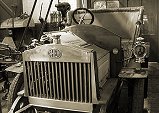 |
The Sedan
Motor Car |
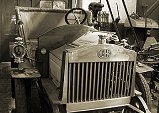 |
| The Sedan Auto-Car Syndicate Limited was founded in
October 1907 with a capital of £10,000 in £1 shares. The company,
based at 51 Lichfield Street, Wolverhampton was founded to acquire the
Burnt Tree Engineering Works, Tipton and their interest in two patents.
The first, taken out by Thomas Hugh Parker was for improvements to motor cars, and the second
taken out L. Wirtz, was for
improvements in variable and reversing gear.
The company produced a unique articulated car which was partly or
wholly designed by Thomas Hugh Parker. It is not known how many of these
cars were produced, but it seems likely that they were built at the Tipton Works.
An article about the car appeared in the "Motor Car Journal" on 2nd
November, 1907. A transcript of it follows: |
|
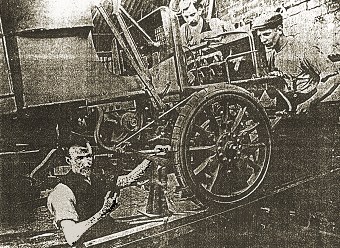
Building one of the cars. Courtesy of the late Jim Boulton. |
An exceedingly novel design of motor-cab chassis is being put on the
market by the Sedan Auto Car Syndicate, Ltd., Lichfield Street,
Wolverhampton.
As will be seen from the accompanying illustration, the
frame is in two distinct parts, the engine and transmission gear being
all supported on the forward frame, the front pair of road wheels acting
both as steerers and drivers. |
| The two parts of the frame are connected together by a hinged
connection so arranged that while perfect rigidity is ensured, each
pair of road wheels can be turned in a similar manner to the "lock"
on a horse-drawn four-wheeled vehicle.
Among the advantages claimed
for the new design is the fact that the car can be turned in a very
small radius, and that it works amongst traffic with perfect ease
and safety; the risk of skidding is practically eliminated, the
drive being on the front axle and the engine, gear-box and all
driving and steering gear, together with the driver's seat, being
also mounted on the forward pair of wheels. |
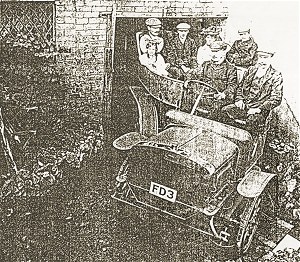
One of the articulated cars. Courtesy of
the late Jim Boulton. |
| There is considerable reduction in the vibration with consequent
reduced cost of upkeep of engine and gear.
The back portion of the car, being essentially a trailer, is well
hung on springs with long centres, and as there are no working
parts underneath, vibration is reduced to a minimum, and solid
tyres can be used. The front chassis is self contained and forms
an avant-train, which can be used for various types of bodies,
as, for instance, with a brougham, an ordinary open car body,
char-a-banc, or light delivery van.
An experimental cab has, we
are informed, been run in London for about eight months, and has
not only proved its adaptability for traffic, but is able to
turn in a circle of a diameter of 21ft, or 4ft. less than the
police requirements. The Sedan company are also introducing a
new change-speed gear known as the Wirtz, which comprises
several novel features, and to which we hope to refer in a later
issue.
|
|
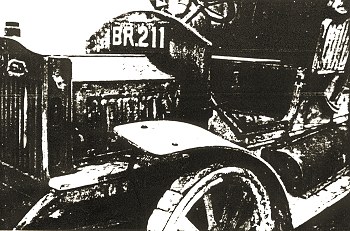
The surviving Sedan car. Courtesy of the
late Jim
Boulton.
|
Thomas Hugh Parker invented the unique pivoting chassis frame,
which pivoted in the middle to provide four wheel steering. It
was developed in 1905 or 1906 and a prototype car soon followed.
The prototype, powered by a four cylinder White and Poppe
engine, ran for eight months as a taxi in London. Its success
led to the formation of the Sedan Auto-Car Syndicate who wished
to market the vehicle as both a car and a commercial lorry. |
| A second prototype still exists and can now be seen
at the Beamish Museum, County Durham. It has a 14hp. twin cylinder
Forman engine with a Rubery Owen chassis. On completion it was sent
from Wolverhampton, by rail to the Marquis of Londonderry's Seaham
Harbour Engine Works in about 1908.
Londonderry steam waggons had been built at the Marquis's works,
and when this venture failed, the company expressed an interest
in manufacturing the Parker vehicle. The car was modified at the
works and a SHEW (Seaham Harbour Engine Works) nameplate was
attached to the radiator. The enterprise failed and only three
vehicles were built, including a lorry for the Parker family's
"Coalite" company.
The SHEW car was kept at the works as a runabout and extensively modified in about 1912. The articulating chassis
steering was removed and replaced with conventional Ackermann
steering. After the First World War the car was used on the
Marquis of Londonderry's estate at Wynyard Park until the onset
of the Second World War when it was stored in one of the
outbuildings on the estate. |
|
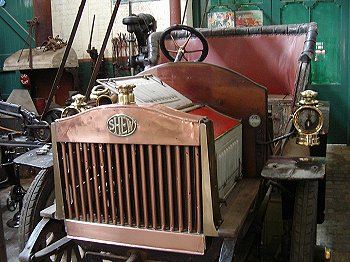
The surviving SHEW car at Beamish Museum. |
In 1956 the remains of the car were discovered by
enthusiast George Kendrew who towed it to his home in
Norton-on-Tees.
He rebuilt the body and replaced the solid-tyred
rims with beaded edge rims and pneumatic tyres. In the 1960s the car
was sold to a garage in Mirfield near Leeds and then sold again to a
private collector in 1967.
Its whereabouts were unknown until it
resurfaced in a Cheffins Auction in June 2003, from where it was
purchased by the Beamish Museum. |
I would like to thank the late Jim Boulton for his help in producing
this section. |
|